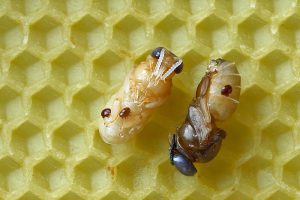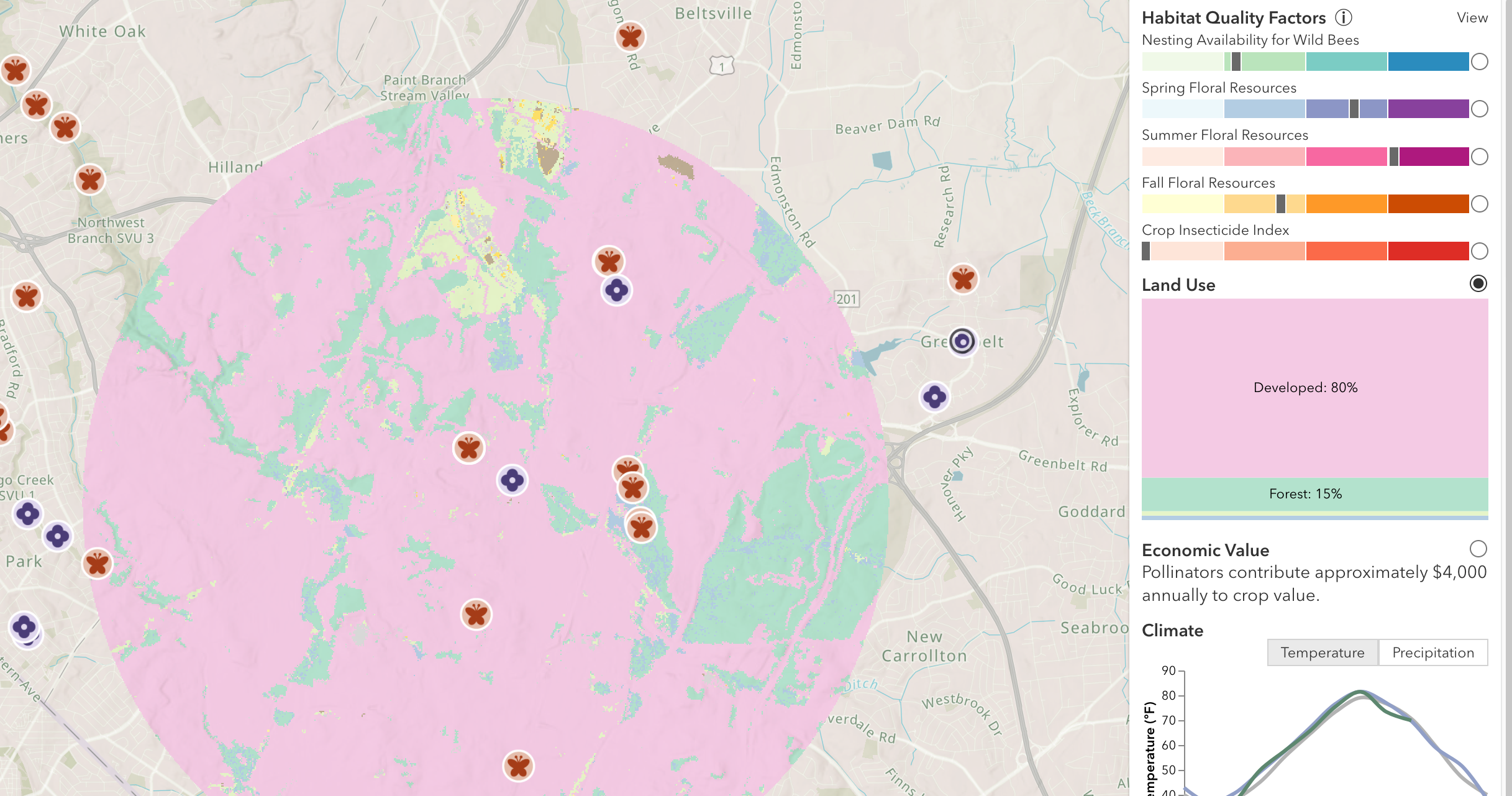 Honey Bee/Varroa Mite/Virus Complex
Honey Bee/Varroa Mite/Virus Complex
Viral diseases of honey bees are a major problem causing serious economic losses worldwide
Clarence Collison
“Viral diseases of honey bees are a major problem causing serious economic losses worldwide, especially in combination with Varroa mites. To increase the understanding of the relationship among viruses, mites and colony decline, the tripartite relationships among bees, viruses [Kashmir bee virus (KBV) and sacbrood virus (SBV)] and Varroa mites were investigated systematically. By using ELISA (enzyme-linked immunosorbent assay) and RT-PCR, (reverse transcriptase polymerase chain reaction; allows identification of pathogenic organisms that are difficult to culture by detecting their genetic material, RNA) the presence of KBV and SBV was studied comparatively in different developmental stages and castes of bees. The results demonstrated that KBV may persist as a viral genome with extremely low levels of viral-capsid proteins and that KBV and SBV can co-infect honey bees. This study indicated the presence of KBV and SBV RNAs in both queens and eggs by RT-PCR, suggesting a route of transovarial transmission. Horizontal transmission is also very likely among adult bees and from adult workers to larvae through contaminated food resources, because both viruses have been detected in all developmental stages and food sources (brood food, honey, pollen and royal jelly). Furthermore, it was demonstrated that mites were another possible route of horizontal transmission, as both viruses were detected in mites and their saliva. This study, for the first time, detected co-occurrence of viruses in Varroa, further underlining the importance of the mites in vectoring different bee viruses. These results indicated that multiple infection routes exist for honey bee viral diseases (Shen et al. 2005b).”
“Varroa destructor infestation of colonies carries and/or promotes replication of honey bee viruses like the Deformed wing virus, the Varroa destructor virus-1, the Acute bee paralysis virus, the Israeli acute bee paralysis virus and the Kashmir bee virus that have been well described and characterized; but viruses exclusively associated with Varroa were not found. To look for viruses that may associate with- or infect V. destructor they performed deep sequencing (RNA-seq) of RNA extracted from honey bees and mites in Varroa-infested untreated colonies. The analytic procedures they used enabled identification of new viruses unique to Varroa and absent in Apis mellifera: an Iflavirus and a virus with homology to Ixodes scapularis (deer or black-legged tick) associated virus 2, that they named Varroa destructor virus 2 (VDV-2) and 3(VDV-3), respectively. They validated these findings sequencing the mite- and honey bee-viromes and in separate mites and honey bees randomly sampled. The complete genomes of VDV-2 and VDV-3 bear 9576 nucleotides and 4202 nucleotides, respectively. Phylogenetic analysis of VDV-3 suggests that it belongs to a new group of viruses (Levin et al. 2016).”
“Large-scale colony losses among managed Western honey bees have become a serious threat to the beekeeping industry in the last decade. Multiple factors contribute to these losses, but the impact of Varroa destructor parasitism is by far the most important, along with the contribution of some pathogenic viruses vectored by the mite. So far, more than 20 viruses have been identified infecting the honey bee, most of them RNA viruses. They may be maintained either as covert infections or causing severe symptomatic infections, compromising the viability of the colony. In silico analysis of available transcriptomic data obtained from mites collected in the USA and Europe, as well as additional investigation with new samples collected locally, allowed the description of three RNA viruses, two of them variants of the previously described VDV-2 (Varroa destructor virus 2) and VDV-3 (Varroa destructor virus 3) and the other a new species reported here for the first time. Their results showed that these viruses were widespread among samples and that they were present in the mites as well as in the bees but with differences in the relative abundance and prevalence. However, they have obtained strong evidence showing that these three viruses were able to replicate in the mite, but not in the bee, suggesting that they are selectively infecting the mite (Herrero et al. 2019).”
“Deformed wing virus (DWV) is a bee-pathogenic, single- and positive-stranded RNA virus that has been involved in severe honey bee colony losses worldwide. DWV, when transmitted horizontally or vertically from bee to bee, causes mainly covert infections not associated with any visible symptoms or damage. Overt infections occur after vectorial transmission of DWV to the developing bee pupae through the ectoparasitic mite Varroa destructor. Symptoms of overt infections are pupal death, bees emerging with deformed wings and shortened abdomens, or cognitive impairment due to brain infection. So far, three variants of DWV, DWV-A, DWV-B, and DWV-C, have been described. While it is widely accepted that V. destructor acts as a vector of DWV, the question of whether the mite only functions as a mechanical vector or whether DWV can infect the mite, thus using it as a biological vector, is hotly debated because in the literature, data can be found that support both hypotheses. In order to settle this scientific dispute, Gisder and Genersch (2021) analyzed putatively DWV-infected mites with a newly established protocol for fluorescence in situ hybridization of mites and demonstrated DWV-specific signals inside mite cells. They provided compelling and direct evidence that DWV-B infects the intestinal epithelium and the salivary glands of V. destructor. In contrast, no evidence for DWV-A infecting mite cells was found. Their data are key to understanding the pathobiology of DWV, the mite’s role as a biological DWV vector, and the quasispecies dynamics of this RNA virus when switching between insect and arachnid host species (Gisder and Genersch 2021).”

“Varroa mite vectoring has resulted in the emergence of virulent Deformed wing virus variants. The basis for such changes in DWV is poorly understood. Most importantly, it remains unclear whether replication of DWV occurs in the mite. In this study, Varroa mites were exposed to DWV type A via feeding on artificially infected honey bees. A significant, 357-fold increase in DWV load was observed in these mites after two days. However, after eight additional days of passage on honey bee pupae with low viral loads, the DWV load dropped by 29-fold. This decrease significantly reduced the mite’s ability to transmit DWV to honey bees. Notably, a negative-strand DWV RNA, which could indicate viral replication, was detected only in mites collected from pupae with high DWV levels but not in the passaged mites. They also found that Varroa mites contain honey bee mRNAs, consistent with the acquisition of honey bee cells which would additionally contain DWV replication complexes with negative-strand DWV RNA. They proposed that transmission of DWV type A by Varroa mites occurs in a non-propagative manner (Posada-Florez et al. 2019).”
“Deformed wing virus is just one of many insect RNA viruses which infect a wide range of hosts. Mordecai et al. (2016) reported the genome sequence of a novel Iflavirus named Moku virus (MV), discovered in the social wasp Vespula pensylvanica collected in Hawaii. Phylogenetic analysis showed that MV is most closely related to Slow bee paralysis virus (SBPV), which is highly virulent in honey bees but rarely detected. Worryingly, MV sequences were also detected in honey bees and Varroa from the same location, suggesting that MV can also infect other hymenopteran and Acari hosts (Mordecai et al 2016).”
“Aggregations of 27 nm virus-like particles were observed in electron microscopy images of sectioned Varroa destructor mite tissue. The scattered occurrence of individual particles and accumulation of the virions in lattices in the cytoplasm gave an apparent indication that the virus replicates in the mite. Sequence analysis of the RNA of the purified virus revealed a genome organization with high similarity to that of members of the genus Iflavirus. Phylogenetic analysis of the polymerase showed that the virus was related most closely to Deformed wing virus (DWV) and Kakugo virus (KV) of bees. The name proposed for this virus is Varroa destructor virus 1(VDV-1). To determine whether VDV-1 replicates in mites, a selective RT-PCR was done to detect the presence of the negative-sense RNA strand. The virus isolate and the closely related DWV could be discriminated by two primer sets, each specific to one virus. Both viruses replicated in the population of the mite species studied (Ongus et al. 2004).”
“Varroa destructor virus-1 is known to cause high rates of overwintering colony losses in Europe. Using next generation sequencing, Ryabov et al. (2017) identified VDV-1 in honey bee pupae in the US. They tested 603 apiaries in 2016 and found that VDV-1 was present in 66.0% of them, making it the second most prevalent virus after DWV, which was present in 89.4% of the colonies. VDV-1 had the highest load in infected bees compared to other tested viruses, with DWV second. Analysis of 75 colonies sourced in 2010 revealed that VDV-1 was present in only 2 colonies (2.7%), suggesting its recent spread. They also detected newly emerged recombinants between the US strains of VDV-1 and DWV. The presence of these recombinants poses additional risk, because similar VDV1-DWV recombinants constitute the most virulent honey bee viruses in the UK (Ryabov et al. 2017).”
“A survey of six bee viruses on a large geographic scale was undertaken in France by using seemingly healthy bee colonies and the PCR technique. Samples of adult bees and pupae were collected from 36 apiaries in the Spring, Summer, and Autumn during 2002. Varroa destructor samples were collected at the end of Summer following acaricide treatment. In adult bees, during the year deformed wing virus (DWV) was found at least once in 97% of the apiaries, sacbrood virus (SBV) was found in 86% of the apiaries, chronic bee paralysis virus (CBPV) was found in 28% of the apiaries, acute bee paralysis virus (ABPV) was found in 58% of the apiaries, black queen cell virus (BQCV) was found in 86% of the apiaries, and Kashmir bee virus (KBV) was found in 17% of the apiaries. For pupae, the following frequencies were obtained: DWV, 94% of the apiaries; SBV, 80% of the apiaries; CBPV, none of the apiaries; ABPV, 23% of the apiaries; BQCV, 23% of the apiaries; and KBV, 6% of the apiaries. In Varroa samples, the following four viruses were identified: DWV (100% of the apiaries), SBV (45% of the apiaries), ABPV (36% of the apiaries), and KBV (5% of the apiaries). The latter findings support the putative role of mites in transmitting these viruses. Taken together, these data indicate that bee virus infections occur persistently in bee populations despite the lack of clinical signs, suggesting that colony disease outbreaks might result from environmental factors that lead to activation of viral replication in bees (Tentcheva et al. 2004).”
“To determine the roles of Varroa mites in activating or vectoring viral infections quantitative comparison of viral infections between bees with and without mites by dot blot analysis and enzyme-linked immunosorbent assay (ELISA) were performed. Under natural and artificial mite infestations, bee pupae contained significantly higher levels of Kashmir bee virus (KBV) and deformed wing virus (DWV) RNAs and KBV structural proteins than mite-free pupae. Moreover, in mite-infested bee pupae, DWV had amplified to extremely high titers with viral genomic RNA being clearly visible after separation of total bee RNA in agarose gels. Linear regression analysis has shown a positive correlation between the number of mites introduced and the levels of viral RNAs. The detection of viral RNAs in the nymph and adult mites underline the possible role of Varroa in virus transmission. However, most groups of virus-free adult mites (9/12) were associated with bee pupae heavily infected by viruses, suggesting that the elevated viral titers in mite-infested pupae more likely resulted from activated viral replication. Based on these observations and their concurrent research demonstrating suppressed immune responses in bees infested with mites, they proposed that parasitization by Varroa suppresses the immunity of honey bees, leading to activation of persistent, latent viral infection (Shen et al. 2005a).”
“Varroa mites and viruses are currently the high-profile suspects in collapsing bee colonies. Therefore, seasonal variation in Varroa load and viruses (Acute-Kashmir-Israeli complex (AKI) and Deformed Wing Virus (DWV)) were monitored in a year-long study. The viral titers in honey bees and Varroa mites from 23 colonies (15 apiaries) under three treatment conditions: Organic acids (11 colonies), pyrethroid (nine colonies) and untreated (three colonies) were investigated. Approximately 200 bees were sampled every month from April 2011 to October 2011, and April 2012. The 200 bees were split to 10 subsamples of 20 bees and analyzed separately, which allows them to determine the prevalence of virus-infected bees. The treatment efficacy was often low for both treatments. In colonies where Varroa treatment reduced the mite load, colonies overwintered successfully, allowing the mites and viruses to be carried over with the bees into the next season. In general, AKI and DWV titers did not show any notable response to the treatment and steadily increased over the season from April to October. In the untreated control group, titers increased most dramatically. Viral copies were correlated to number of Varroa mites. Most colonies that collapsed over the Winter had significantly higher AKI and DWV titers in October compared to survivors. Only treated colonies survived the Winter (Francis et al. 2013).”
References
Francis, R.M., S.L. Nielsen and P. Kryger 2013. Varroa-virus interaction in collapsing honey bee colonies. PLoS ONE 8(3):e57540. doi:10.1371/journal.pone.0057540
Gisder, S. and E. Genersch 2021. Direct evidence for infection of Varroa destructor mites with the bee-pathogenic deformed wing virus variant-B, but not variant-A, via fluorescence in situ hybridization analysis. J. Virol. 95: e01786-20
Herrero, S., A. Millán-Leiva, S. Coll, R.M. González-Martínez, S. Parenti and J. González-Cabrera 2019. Identification of new viral variants specific to the honey bee mite Varroa destructor. Exp. Appl. Acarol. 79: 157-168.
Levin, S., N. Sela and N. Chejanovsky 2016. Two novel viruses associated with the Apis mellifera pathogenic mite Varroa destructor. Sci. Rep. 6: 37710, doi:10.1038/srep37710
Mordecai, G.J., L.E. Brettell, P. Pachori, E.M. Villalobos, S.J. Martin, I.M. Jones and D.C. Schroeder 2016. Moku virus, a new Iflavirus found in wasps, honey bees and Varroa. Sci. Rep. 6: 34983 doi: 10.1038/srep34983
Ongus, J.R., D. Peters, J.-M. Bonmatin, E. Bengsch, J.M. Vlak and M.M. van Oers 2004. Complete sequence of a picorna-like virus of the genus Iflavirus replicating in the mite Varroa destructor. J. Gen. Virol. 85: 3747-3755.
Posada-Florez, F., A.K. Childers, M.C. Heerman, N.I. Egekwu, S.C. Cook, Y. Chen, J.D. Evans, and E.V. Ryabov 2019. Deformed wing virus type A, a major honey bee pathogen, is vectored by the mite Varroa destructor in a non-propagative manner. Sci. Rep. 9:12445 doi:org/10.1038/s41598-019-47447-3
Ryabov, E.V., A.K. Childers, Y. Chen, S. Madella, A. Nessa, D. vanEngelsdorp and J.D. Evans 2017. Recent spread of Varroa destructor virus-1, a honey bee pathogen, in the United States. Sci. Rep. 7:17447 doi:10.1038/s41598-017-17802-3
Shen, M., X. Yang, D. Cox-Foster, and L. Cui 2005a. The role of Varroa mites in infections of Kashmir bee virus (KBV) and deformed wing virus (DWV) in honey bees. Virology 342: 141-149.
Shen, M., L. Cui, N. Ostiguy and D. Cox-Foster 2005b. Intricate transmission routes and interactions between picorna-like viruses (Kashmir bee virus and sacbrood virus) with the honeybee host and the parasitic Varroa mite. J. Gen. Virol. 86: 2281-2289.
Tentcheva, D., L. Gauthier, N. Zappulla, B. Dainat, F. Cousserans, M.E. Colin and M. Bergoin 2004. Prevalence and seasonal variations of six bee viruses in Apis mellifera L. and Varroa destructor mite populations in France. Appl. Environ. Microbiol. 70: 7185-7191.
Clarence Collison is an Emeritus Professor of Entomology and Department Head Emeritus of Entomology and Plant Pathology at Mississippi State University, Mississippi State, MS.









